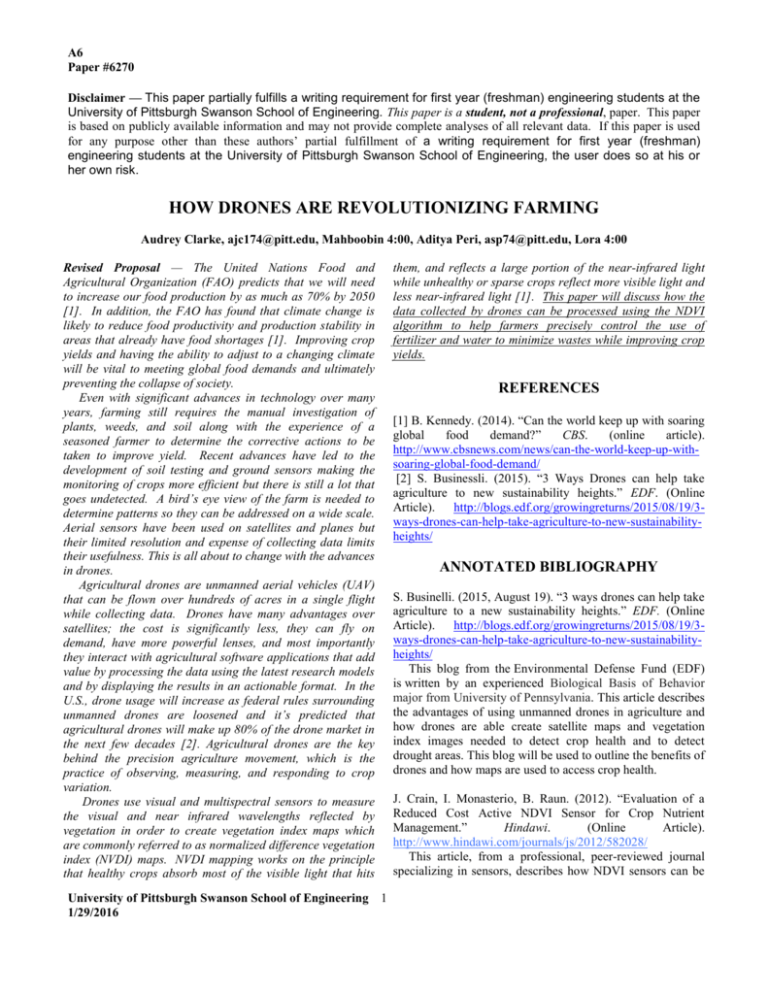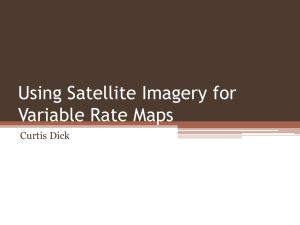how drones are revolitionizing farming
advertisement

A6 Paper #6270 Disclaimer — This paper partially fulfills a writing requirement for first year (freshman) engineering students at the University of Pittsburgh Swanson School of Engineering. This paper is a student, not a professional, paper. This paper is based on publicly available information and may not provide complete analyses of all relevant data. If this paper is used for any purpose other than these authors’ partial fulfillment of a writing requirement for first year (freshman) engineering students at the University of Pittsburgh Swanson School of Engineering, the user does so at his or her own risk. HOW DRONES ARE REVOLUTIONIZING FARMING Audrey Clarke, ajc174@pitt.edu, Mahboobin 4:00, Aditya Peri, asp74@pitt.edu, Lora 4:00 Revised Proposal — The United Nations Food and Agricultural Organization (FAO) predicts that we will need to increase our food production by as much as 70% by 2050 [1]. In addition, the FAO has found that climate change is likely to reduce food productivity and production stability in areas that already have food shortages [1]. Improving crop yields and having the ability to adjust to a changing climate will be vital to meeting global food demands and ultimately preventing the collapse of society. Even with significant advances in technology over many years, farming still requires the manual investigation of plants, weeds, and soil along with the experience of a seasoned farmer to determine the corrective actions to be taken to improve yield. Recent advances have led to the development of soil testing and ground sensors making the monitoring of crops more efficient but there is still a lot that goes undetected. A bird’s eye view of the farm is needed to determine patterns so they can be addressed on a wide scale. Aerial sensors have been used on satellites and planes but their limited resolution and expense of collecting data limits their usefulness. This is all about to change with the advances in drones. Agricultural drones are unmanned aerial vehicles (UAV) that can be flown over hundreds of acres in a single flight while collecting data. Drones have many advantages over satellites; the cost is significantly less, they can fly on demand, have more powerful lenses, and most importantly they interact with agricultural software applications that add value by processing the data using the latest research models and by displaying the results in an actionable format. In the U.S., drone usage will increase as federal rules surrounding unmanned drones are loosened and it’s predicted that agricultural drones will make up 80% of the drone market in the next few decades [2]. Agricultural drones are the key behind the precision agriculture movement, which is the practice of observing, measuring, and responding to crop variation. Drones use visual and multispectral sensors to measure the visual and near infrared wavelengths reflected by vegetation in order to create vegetation index maps which are commonly referred to as normalized difference vegetation index (NVDI) maps. NVDI mapping works on the principle that healthy crops absorb most of the visible light that hits University of Pittsburgh Swanson School of Engineering 1 1/29/2016 them, and reflects a large portion of the near-infrared light while unhealthy or sparse crops reflect more visible light and less near-infrared light [1]. This paper will discuss how the data collected by drones can be processed using the NDVI algorithm to help farmers precisely control the use of fertilizer and water to minimize wastes while improving crop yields. REFERENCES [1] B. Kennedy. (2014). “Can the world keep up with soaring global food demand?” CBS. (online article). http://www.cbsnews.com/news/can-the-world-keep-up-withsoaring-global-food-demand/ [2] S. Businessli. (2015). “3 Ways Drones can help take agriculture to new sustainability heights.” EDF. (Online Article). http://blogs.edf.org/growingreturns/2015/08/19/3ways-drones-can-help-take-agriculture-to-new-sustainabilityheights/ ANNOTATED BIBLIOGRAPHY S. Businelli. (2015, August 19). “3 ways drones can help take agriculture to a new sustainability heights.” EDF. (Online Article). http://blogs.edf.org/growingreturns/2015/08/19/3ways-drones-can-help-take-agriculture-to-new-sustainabilityheights/ This blog from the Environmental Defense Fund (EDF) is written by an experienced Biological Basis of Behavior major from University of Pennsylvania. This article describes the advantages of using unmanned drones in agriculture and how drones are able create satellite maps and vegetation index images needed to detect crop health and to detect drought areas. This blog will be used to outline the benefits of drones and how maps are used to access crop health. J. Crain, I. Monasterio, B. Raun. (2012). “Evaluation of a Reduced Cost Active NDVI Sensor for Crop Nutrient Management.” Hindawi. (Online Article). http://www.hindawi.com/journals/js/2012/582028/ This article, from a professional, peer-reviewed journal specializing in sensors, describes how NDVI sensors can be Audrey Clarke Aditya Peri used to increase fertilizer nitrogen efficiency. This article provides a table with recommended changes in nitrogen levels based on varying NDVI levels. This article can be used in our paper to show how NDVI measurements actually translate to actionable plans to be taken by the farmer. will use this source to compare and contrast infrared images from satellites to drone sensors. R. Rohr. (2014, January 21). “Meet the New Drone That Could Be a Farmer’s Best Friend.” Modern Farmer. (Online Article). http://modernfarmer.com/2014/01/precision-hawk/ This article from the Modern Farmer, which is the authoritative resource for today’s cutting-edge food producers and consumers, explores Precision Hawk’s Lancaster drone. This drone captures images of vegetation indexes by using its multispectral sensors. Additionally, this drone is able to cover a lot of ground and upload all data to its cloud systems. We will use this drone’s features in our paper to show the benefits of UAVs in the agricultural industry. (2015). “Emerging Risk Report.” Lloyds. (online report) http://www.lloyds.com/~/media/files/news%20and%20insigh t/risk%20insight/2015/food%20system%20shock/food%20sy stem%20shock_june%202015.pdf This research article from Lloyd’s of London, a global insurer, describes the impacts to society of a major disruption to the global food supply. The report describes how climate change and water scarcity can drastically lower crop yield and trigger a shock in food prices and possible political instability. Information from this article will help us show the importance of minimizing water waste and reacting quickly to climate changes to prevent crop loss. (2014, June 9). “Variable Rate Nutrient Application: Should I Consider it For My Farm?” Agriculture and Agri-Food Canada. (Online Article). http://www.agr.gc.ca/eng/scienceand-innovation/agricultural-practices/soil-and-land/soilnutrients/variable-rate-nutrient-application-should-i-considerit-for-my-farm-/?id=1368026127650 This article was written by the Agriculture and Agri-Food Canada (AAFC), a Canadian government program which supports sustainable farming. The article describes how aerial mapping can create soil management zones which are areas within a field that need different levels of nutrient additions. We can use this information in our paper to show how NDVI numbers correspond to soil sampling and to specific recommendations for water and fertilizer adjustments. (2014, June 10). “Misconceptions about UAV-collected NDVI imagery and the Agribotix experience in ground trothing these images for agriculture.” Agribotix. (Online Article). http://agribotix.com/blog/2014/6/10/misconceptionsabout-uav-collected-ndvi-imagery-and-the-agribotixexperience-in-ground-truthing-these-images-for-agriculture This blog is written by Agribotix, an agricultural intelligence company, and focuses on NDVI imaging. The article describes the background on the development of NDVI and contains detailed diagrams of NDVI imaging. It also describes how healthy, unhealthy, and dead vegetation reflects NIR and visible light. Information from this blog will support the focus of our paper on how the NDVI algorithms effectively detect crop health and improve yields. J. Wihbey. “Agricultural drones may change the way we farm.” The Boston Globe. (Online Article). https://www.bostonglobe.com/ideas/2015/08/22/agriculturaldrones-change-wayfarm/WTpOWMV9j4C7kchvbmPr4J/story.html This article from the Boston Globe, a newspaper, discusses how drones are the future of the farming industry and how federal rules on the use on UAV’s have been recently loosened for the farming community. It also discusses several universities that have been researching farming techniques as they relate to the big data being collected by drones. We will use the information from this article to show how farming research and data analysis can improve farming efficiency. (2015). “Precision Farming Toolkit.” Arable Farming. (PDF). http://www.cffertilisers.co.uk/media/1911/precision-farmingtoolkit-final.pdf This precision farming guide was published jointly by CF Fertilizers, Claas, and Agrii. These companies specialize in fertilizer, agricultural machinery, and agronomy services respectively. This guide describes how soil management through yield mapping can lead to intelligent soil sampling and how soil factors into irrigation and fertilizer control. Information from this article will be used to explain why different soil types need specialized care. (2010). “Reflected Near-Infrared Waves”. NASA Science. (Online Article). http://missionscience.nasa.gov/ems/08_nearinfraredwaves.ht ml This technical article from NASA explains the concept of Infrared Radiation being reflected and absorbed to show vegetation health and soil conditions. It goes into depth about how to identify healthy vegetation and to identify spectral signatures. Additionally, it provides information on accessing information on soil and vegetation from space satellites. We 2






